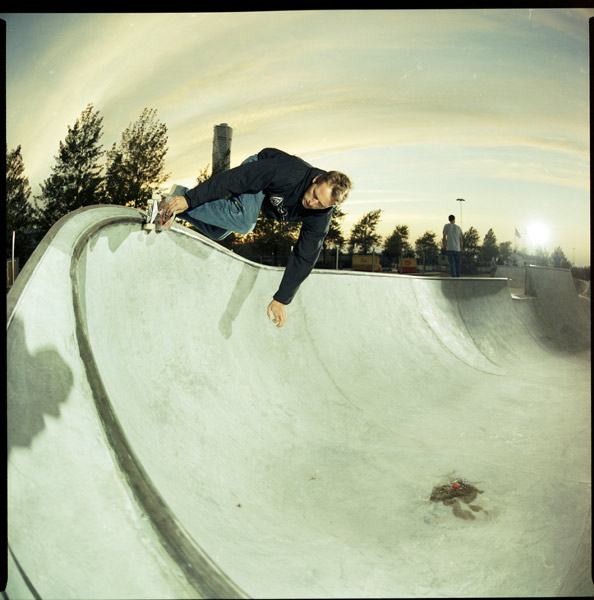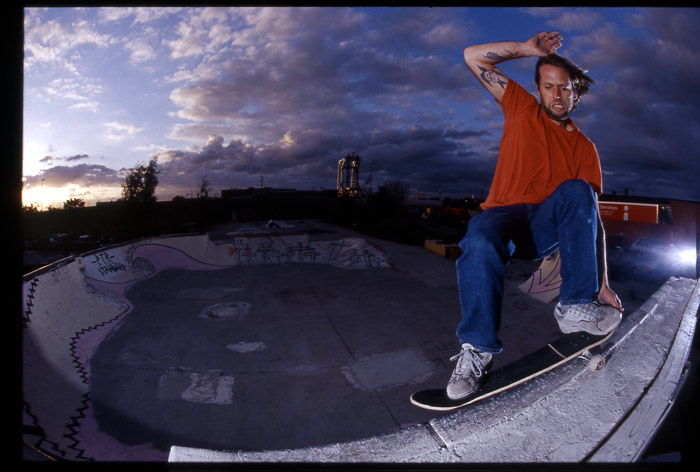Stefan Hauser – Placed to Ride
Stefan Hauser – Placed to Ride’ designer builder is making it happen around the world.
 Please tell us your background in skateboarding and skatepark design/construction. How did you start?
Please tell us your background in skateboarding and skatepark design/construction. How did you start?
I started skateboarding in middle school. Shortly thereafter I began building small fly-away ramps, quarter-pipes and spines out in the street in front of my house. Each ramp was good for a season or two. Then I would dismantle them and rebuild with the remaining materials. These small ramps and the streets were all we had to ride back then. These weren’t really skateparks, but that is what we had, and people would travel from all parts of town to skate these obstacles.

Did you move your company from Oregon to Puerto Rico?
Placed To Ride works in various parts of the globe. It is an Oregon registered corporation. That was quite a natural place to start the business as that is where I grew up and always called home. Right now, Placed To Ride is in transition and moving the offices to Puerto Rico. We will still work to service the greater global community, but are also look at maintaining a permanent fixture here in PR.
When did you get the notion that building skateparks could turn into a living?
In 1998, I gave it a lot of thought. Public skateparks were just beginning in Oregon. I had both skateboarding and construction experience, so I thought it was a great opportunity to build top notch parks plus create a career. I teamed up with Mark Scott from Burnside, and after six months, we landed our first job in Lincoln City. We built the best park we could. After that, our reputation attracted more jobs. Looking back it was very good timing indeed.
I always thought I was so lucky to have grown up skating Burnside and had a mission to extend this opportunity to others.
Do you like working with wooden ramps or concrete more? Which do you like to skate more?
I don’t build wooden ramps any more, only concrete. I’ve always liked riding concrete more plus I like the idea that my work will be around for future generations to enjoy.
Wooden ramps are best for indoors or dry climates. They don’t meet most cities’ needs.
What is your favorite design you’ve built?
I really like Lincoln City 1, Newberg, Aumsville, The Cradle in Brixlegg, Stapelbaddsparken, Avesta and my latest construct, Gothenburg. I like parks with a good flow and a variety of obstacles and elevations. Seaside and Cannon Beach, Oregon are great parks for small towns.
What is your favorite skatepark all-time?
Burnside. It has a lot to do with nostalgia, last time I went there I was shaking because it was so much fun. There are a lot of memories.
Have you ever tried to re-create anything from the past into a build?
Of course you take certain elements with you from design to design. Really, how original can you make a design before it doesn’t work. A car is still a car, a skatepark is still a skatepark. You always must include a little bread and butter with your meal, so why not the same with a skatepark. When designing a park, I try to serve the local youth first and foremost. Then I get creative and try to incorporate new elements. With concrete, it is always best to create new designs and never build the same twice. It leads to more fun and more travels.
How long ago did you get your contractors permit and go legit?
Placed To Ride was established in 2002. We received our contractor’s license the same year.
What has been the most difficult aspect of getting a city to choose Placed to Ride for a job?
Obviously, my competition. In my experience, you can pretty much guess going into a tender who is going to win it. The process is supposed to be open and fair, but in the end the committee is almost always leaning towards one firm or another. Sometimes, it works to your advantage and sometimes it works against you. It also doesn’t help that my works are so geographically spread out.

How many parks can your company build in a year?
We are a small firm, we build an average of two constructions per year. The monster parks I have been building in Sweden take up a lot of my time. I normally also do some additional design work. This year some of my workers built a park in Innsbruck, Austria. I only did the design. I wasn’t there for the construction. It turned out good and I am stoked. It is always a challenge with planning. I can only be in one place at a time.
Do you think jobs are going to start drying up as the economy starts falling apart?
I don’t believe skateparks will start drying up because of the economy. In fact, I think public works will increase as a stimulus to the economy. I believe the work will start drying up when every small town has a park and every large town has between two and five. Then there will be work left to redesign the bad ones, plus always maintenance work. The really big mistake would be if laws changed and people began suing for liability damages. That was always the fear back in the 80’s.
How do you bring in new people to help build or train?
I still try to hand select my workers as much as I can. I also try to keep my best workers around. Workers and their families inevitably get burnt out on the travels.
How much feedback to you get on your designs before beginning the build?
It really varies enormously from job to job. I like to get to know the skaters who will use the park. The best input I get is generally on the conceptual level rather than on minute details and kinds of obstacles. Skaters have to remember that they are hiring a professional to design the park. Often, they want an infinite number of obstacles in a finite space, which muddies up the design. You have to consider flow and prioritize.
How do you handle the street skater mentality vs. bowl rider and how does it play out when designing parks?
A good design accommodates both user groups. Usually street obstacles take up more space than bowls. Sometimes you can incorporate obstacles around the perimeter of the park. This can be fun when it does not interfere with the activities in the middle. I like when everything flows together as one whole. Sometimes this is possible and sometimes this is not. It depends on what the skaters ask for and the anticipated number of users in each area.
Sometimes going into a design I have preconceived notions about how much street or how much bowl should be in a park. Then I meet with the locals and the set new standards. I must listen to them.
What do you like most about completing a new skatepark?
Riding it.
Do you feel that standards should be set up for skatepark builders?
Yes, I think they should be responsible for building durable, safe parks that will maintain the interests of users for a long time. Maybe there should be an association of skatepark companies or something. We, the builders, almost all know each other on a first name bases, but we are also competing against each other. In one way or another I have worked hand in hand with several of the company owners. If there was an association it would be better for the cities to see who’s who, but right now they can almost all find this out quite readily. In Europe, though, there is still a lot to be learned.
What is the biggest misconception skaters have about building skateparks?
They can have everything. Sometimes less is more.
How is it dealing with builders over in Europe? Language barriers, technique barriers? Anyone show any promise over there?
Yes, language can be a barrier, but by far the hardest barrier in Europe is the lack of experience in this field. Also the general, lack of experience in cast in-place concrete is a problem.
Engineers without skatepark construction experience can make additional nightmares, too.
—————————————————————————————-
Stefan Hauser is the CEO of Placed To Ride and can be reached at:
Placed To Ride, inc.
PO Box 670
Quebradillas, PR
00687
stefan@placed-to-ride.com
http://www.placed-to-ride.com
Tel. (503) 440-4819
